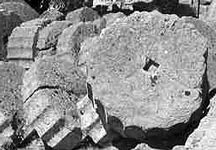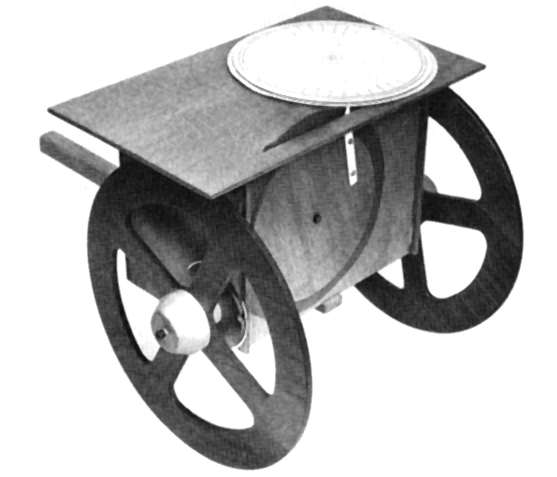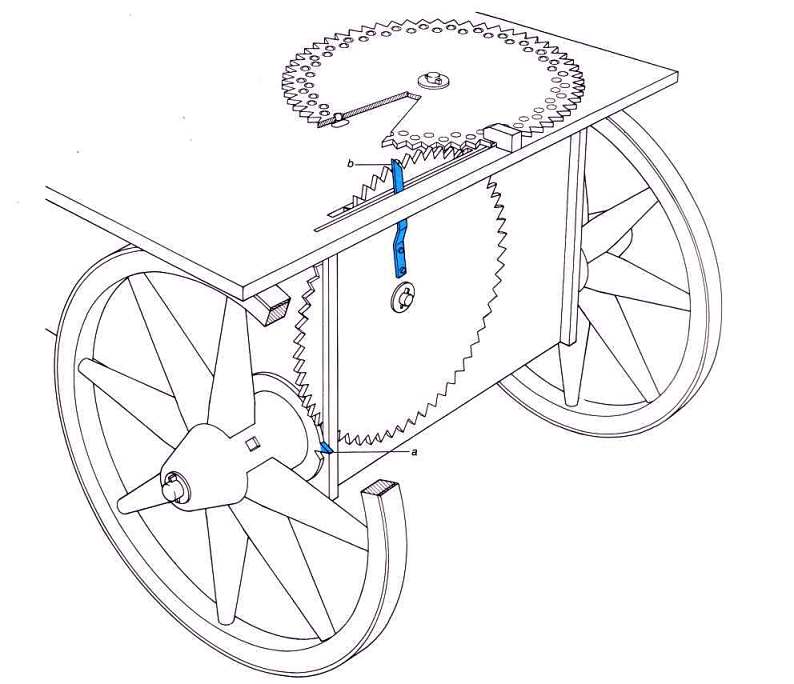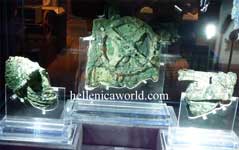.
Aristotle mentions gears around 330 BC, (wheel drives in windlasses). He said that the direction of rotation is reversed when one gear wheel drives another gear wheel. Philon of Byzantium was one of the first who used gears in water raising devices. Archimedes used gears in various constructions. Actually we have only indirect knowledge of his inventions. He did not publish any work describing his inventions. He viewed his mechanical inventions as amusements or as practical concerns of no scientific importance. Plutarch says: ''Although these inventions made his superhuman wisdom famous, he nonetheless wrote nothing on these matters because he felt that the construction of all machines and all devices for practical use in general was a low and ignoble business. He himself strove only to remove himself, by his handsomeness and perfection, far from the kingdom of necessity."

Column drums of a Greek Temple, almost looking like Gears (Olympia Zeus Temple)
Archimedes is considered to have used gears for:

-
A clock that each hour releases a small metallic sphere that falling inside a container produces a sound marking the start of a new hour.

An odometer. Again a small metallic sphere is released after a specific distance. The number of these small spheres is counted and the distance is thus determined (or the distance can directly be read from a scale).

A reconstruction of the odometer developed by Archimedes.
 v
v
A drawing of the gears used in Archimedes odometer.
-
The Antikythera device which some consider to be developed by Archimedes at least indirect as Archimedes is known to have build so-called planetaria, devices that model the movement of planets and the sun. Two such devices were said to have been rescued from Syracuse when it fell in 212 BC. Also these devices used gears.


Gears in the Antikythera device

A reconstruction of the Antikythera device
Gears were used by others also:
-
Heron of Alexandria
-
Dionysius of Alexandria
A “inverted” version of gears was used by Dionysius of Alexandria in his repeating automatically firing catapult device that fired many arrows like a machine gun.

The polybolos with its two pentagonal gears linked by a chain drive powered by a windlass.
Most complex catapult invented in ancient times was a repeating weapon designed by Dionysius of Alexandria, who worked in the arsenal at Rhodes. As this detail drawing shows, arrows were fed by gravity from a magazine into the arrow trough by means of a revolving drum that was slotted to accept one shaft at a time. The revolution of the drum was controlled by a curved cam groove on its surface, which engaged a metal finger mounted on the slider. The motion of the slider was in turn produced by two flat-linked chains on each side to the machine. According to the surviving text describing the repeater, the chains ran over five-sided prisms at each end of their loop. In the author’s view these prisms are assumed to have worked as inverted gears; in other words, the chain-link drive for the cocking and firing sequence relied on an engagement between the lugs on the chain links and a pentagonal gear for accepting the lugs. The rear prism was turned by a winch, and the bowstring claw was locked and unlocked at the appropriate times by pegs mounted in the stock of the weapon, past which the slider moved. Hence by reciprocating the winch the device could fire arrows automatically until the magazine was empty.

Links
Reconstruction of the Antikythera Device
Animations of an Antikythera device reconstruction
Gears from the Ancient Greeks
See also Ancient Greek Inventions
How Gears Work
Some Information about Gears (French Website)
André Wegener Sleeswyk, "Vitruvius' Odometer", Scientific American 245(4) October, 1981, pp. 188-200
http://www.database.com/~lemur/rb-rolling-ball.html
Price D. de S. (1959) “An Ancient Greek Computer”, Scientific American p. 60-67
Lewis, M. J. T. (1983) “Gearing in the Ancient World” Endeavour, p. 110-115
Brian Hayes , On the teeth of Wheels , Computing Science, American Scientist (PS File)
Price, D. J. de S. (1974) “Gears form the Greeks: the Antikythera Mechanism - a Calendar Computer from ca. 80BC” :
Rice, R. S. (1996) “The Antikythera Mechanism: Physical and Intellectual Salvage from the 1st Century B.C.”11th April 1996.
Christos Lazos, " ΥΠΟΛΟΓΙΣΤΗΣ ΤΩΝ ΑΝΤΙΚΥΘΗΡΩΝ", AEOLOS (Greek book)
American Mathematical Society: http://www.mathlab.sunysb.edu/~tony/whatsnew/column/antikytheraI-0400/kyth1.html
More Images From Collection of Bronzes: http://www.culture.gr/2/21/214/21405m/e21405m4.html
German Reports
Deutsches Museum-Maschinenelemente (English Version)
Rezirkulations-Mühlen
| Ancient Greece
Science, Technology , Medicine , Warfare, , Biographies , Life , Cities/Places/Maps , Arts , Literature , Philosophy ,Olympics, Mythology , History , Images Medieval Greece / Byzantine Empire Science, Technology, Arts, , Warfare , Literature, Biographies, Icons, History Modern Greece Cities, Islands, Regions, Fauna/Flora ,Biographies , History , Warfare, Science/Technology, Literature, Music , Arts , Film/Actors , Sport , Fashion --- |

